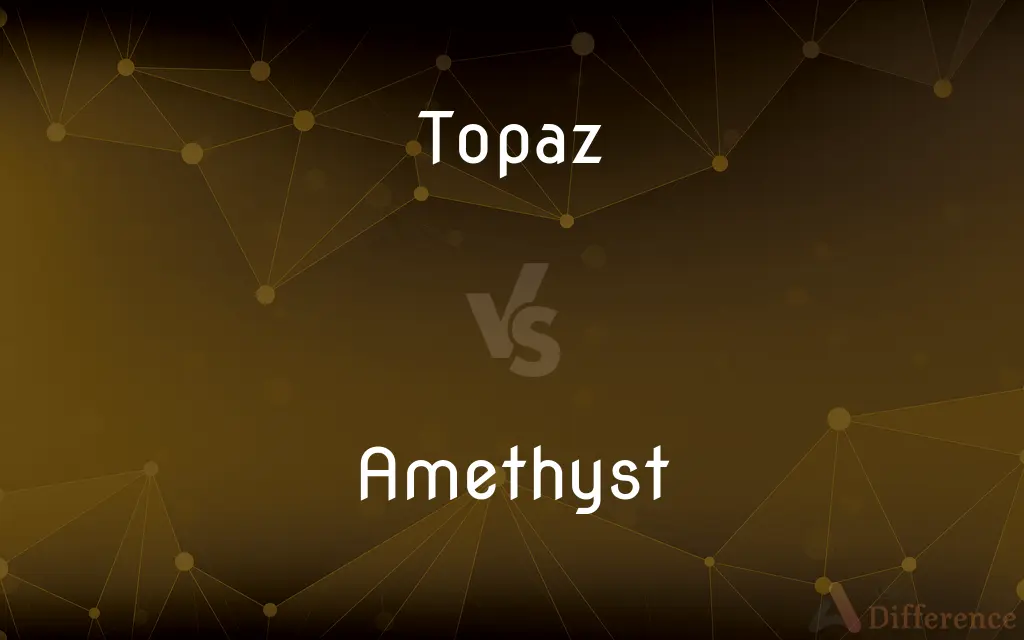Topaz vs. Amethyst — What's the Difference?
By Maham Liaqat & Fiza Rafique — Updated on April 22, 2024
Topaz and amethyst are both silicate minerals, but topaz is typically yellow or colorless, while amethyst is renowned for its vibrant purple hue.

Difference Between Topaz and Amethyst
Table of Contents
ADVERTISEMENT
Key Differences
Topaz is a silicate mineral of aluminum and fluorine, often found in a variety of colors, including yellow, blue, pink, peach, gold, green, and sometimes colorless. On the other hand, amethyst, a type of quartz, is primarily known for its striking purple color, ranging from light lavender to deep violet.
The hardness of topaz on the Mohs scale is 8, making it one of the harder gemstones, ideal for jewelry that withstands everyday wear. Whereas amethyst has a slightly lower hardness of 7, which still allows it to be durable but requires a bit more care to avoid scratches.
Topaz can sometimes undergo treatments to enhance or change its color; common treatments include heat treatment and irradiation. Meanwhile, amethyst may also be treated, typically by heat, to deepen or change its color, though its natural color is often left as is due to its popularity.
Historically, topaz has been used in various cultures for its supposed healing properties and as a gemstone that could cool boiling water or hot tempers. Amethyst’s history, by contrast, often revolves around its believed ability to prevent intoxication and clear-headedness, historically worn by royalty for its color and mystical properties.
The value of topaz varies widely depending on the color and clarity, with imperial topaz and pink varieties generally being the most valuable. Amethyst, though once considered precious, has become more accessible and less expensive since large deposits were found in Brazil, reducing its rarity and price.
ADVERTISEMENT
Comparison Chart
Composition
Aluminum silicate fluoride hydroxide
Silicon dioxide
Typical colors
Yellow, blue, pink, peach, clear
Purple, ranging from light to deep violet
Hardness (Mohs)
8
7
Common treatments
Heat treatment, irradiation
Heat treatment
Historical use
Healing properties, cooling effects
Prevention of intoxication, clarity
Compare with Definitions
Topaz
A gemstone that is valued for its clarity and variety of colors.
She wore a necklace with a pink topaz pendant.
Amethyst
Historically worn by royalty and associated with sobriety.
Ancient Greeks wore amethyst and believed it prevented intoxication.
Topaz
Historically believed to have cooling properties.
Medieval texts claimed that topaz could cool boiling water.
Amethyst
Available in various cuts and sizes as a gemstone.
The jeweler showed us several amethysts, explaining the benefits of each cut.
Topaz
A silicate mineral of aluminum and fluorine, typically found in igneous rocks.
The raw topaz crystal we found was a beautiful clear blue.
Amethyst
A type of quartz that exhibits a range of purple colors.
The amethyst geode displayed deep violet hues that sparkled under the light.
Topaz
Can be treated to enhance color and clarity.
The blue topaz in her earrings was enhanced through a common heat treatment.
Amethyst
Valued for both its beauty and supposed mystical properties.
Amethyst is popular in crystal healing for its purported calming effects.
Topaz
Known for its hardness and durability in jewelry making.
Topaz is often chosen for engagement rings due to its hardness.
Amethyst
Commonly used in fine and decorative jewelry.
His gift was a delicate amethyst bracelet.
Topaz
Topaz ( TOH-paz) is a silicate mineral of aluminium and fluorine with the chemical formula Al2SiO4(F, OH)2. It is used as a gemstone in jewelry and other adornments.
Amethyst
Amethyst is a violet variety of quartz. The name comes from the Koine Greek αμέθυστος amethystos from α- a-, "not" and μεθύσκω (Ancient Greek) methysko / μεθώ metho (Modern Greek), "intoxicate", a reference to the belief that the stone protected its owner from drunkenness.
Topaz
A precious stone, typically colourless, yellow, or pale blue, consisting of an aluminium silicate that contains fluorine.
Amethyst
A precious stone consisting of a violet or purple variety of quartz
Amethyst earrings
A delicate necklace of amethysts and pearls
Topaz
A large tropical American hummingbird with a yellowish throat and a long tail.
Amethyst
A purple or violet form of transparent quartz used as a gemstone.
Topaz
A colorless, blue, yellow, brown, or pink aluminum silicate mineral, often found in association with granitic rocks and valued as a gemstone.
Amethyst
A purple variety of corundum used as a gemstone.
Topaz
Any of various yellow gemstones, especially a yellow variety of sapphire or corundum.
Amethyst
A moderate purple to grayish reddish purple.
Topaz
A light yellow variety of quartz.
Amethyst
A transparent purple variety of quartz, used as a gemstone.
Topaz
A silicate mineral of aluminium and fluorine, usually tinted by impurities.
Amethyst
(uncountable) A purple colour.
Topaz
An often clear, yellowish-brown gemstone cut from this.
Amethyst
(tincture) The tincture purpure, when emblazoning the arms of the English nobility.
Topaz
A yellowish-brown color, like that of the gemstone.
Amethyst
Having a colour similar to that of the gemstone
Topaz
A black Catholic soldier in the British Army.
Amethyst
A variety of crystallized quartz, of a purple or bluish violet color, of different shades. It is much used as a jeweler's stone.
Topaz
Either of two species of very large hummingbirds in the genus Topaza.
Amethyst
A purple color in a nobleman's escutcheon, or coat of arms.
Topaz
A ruby-topaz hummingbird, Chrysolampis mosquitus, the male of which has bright ruby feathers on the head and topaz on the throat
Amethyst
A transparent purple variety of quartz; used as a gemstone
Topaz
Of a yellowish-brown color, like that of the gemstone.
Amethyst
Of a moderate purple color
Topaz
A mineral occurring in rhombic prisms, generally yellowish and pellucid, also colorless, and of greenesh, bluish, or brownish shades. It sometimes occurs massive and opaque. It is a fluosilicate of alumina, and is used as a gem.
Topaz
Either one of two species of large, brilliantly colored humming birds of the genus Topaza (Topaza pella or Topaza pyra), of South America and the West Indies.
Topaz
A yellow quartz
Topaz
A mineral (fluosilicate of aluminum) that occurs in crystals of various colors and is used as a gemstone
Topaz
A light brown
Common Curiosities
What are the most valuable types of topaz?
Imperial topaz and pink topaz are considered the most valuable.
What is the primary chemical difference between topaz and amethyst?
Topaz is a silicate of aluminum and fluorine, while amethyst is made up of silicon dioxide.
Is topaz or amethyst better for everyday jewelry?
Topaz, with its higher hardness, is more suitable for everyday wear.
Which is harder, topaz or amethyst?
Topaz has a Mohs hardness of 8, making it harder than amethyst, which has a hardness of 7.
What makes amethyst distinctive among quartz minerals?
Its vibrant purple color sets it apart in the quartz family.
Can topaz or amethyst change color over time?
Prolonged exposure to sunlight can fade amethyst, while topaz is generally stable.
Can the color of topaz and amethyst be enhanced?
Yes, both stones can undergo treatments such as heat to enhance or change their color.
Why has amethyst become less expensive over time?
The discovery of extensive deposits in Brazil made amethyst less rare and thus less expensive.
Are there synthetic versions of topaz and amethyst available?
Yes, synthetic versions of both stones are available and are often used in jewelry.
Where are topaz and amethyst typically mined?
Topaz is mined in places like Brazil, Nigeria, and Australia; amethyst is also prominent in Brazil.
What were the historical beliefs associated with topaz?
Topaz was thought to have healing properties and the ability to cool boiling water or temper.
What are the mystical properties attributed to amethyst?
Amethyst is believed to bring clarity and prevent intoxication.
Do both gemstones come in multiple colors?
Topaz naturally occurs in a variety of colors, while amethyst is primarily purple.
How do the prices of topaz and amethyst compare?
Amethyst generally tends to be less expensive than topaz, especially the rare colors of topaz.
What jewelry settings are best for amethyst?
Protective settings are recommended for amethyst due to its lower hardness.
Share Your Discovery

Previous Comparison
Background vs. Backdrop
Next Comparison
Flip vs. FlickAuthor Spotlight
Written by
Maham LiaqatCo-written by
Fiza RafiqueFiza Rafique is a skilled content writer at AskDifference.com, where she meticulously refines and enhances written pieces. Drawing from her vast editorial expertise, Fiza ensures clarity, accuracy, and precision in every article. Passionate about language, she continually seeks to elevate the quality of content for readers worldwide.
















































